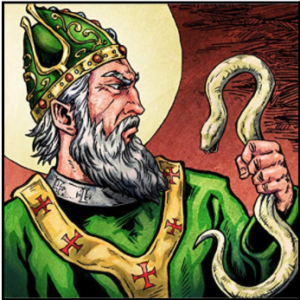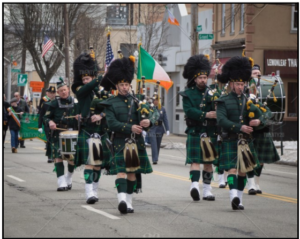
Saint Patrick’s Day
by Jordin Lim
Saint Patrick’s Day, well known for clever leprechaun-catching and for pinching those not wearing green, has an interesting history and fascinating traditions. Saint Patrick’s Day traditionally takes place on March 17th, but how did this day come to be?
The Origins of Saint Patrick’s Day
 Saint Patrick is one of Christianity’s most widely known figures. Born in Roman Britain and alive during the fifth century, Saint Patrick is the patron saint of Ireland and its national apostle.
Saint Patrick is one of Christianity’s most widely known figures. Born in Roman Britain and alive during the fifth century, Saint Patrick is the patron saint of Ireland and its national apostle.
After being kidnapped by a group of Irish raiders who had been attacking his family’s estate, he was brought to Ireland at age 16, where he spent six years in captivity. During this time in captivity, Patrick worked as a shepherd, away from people. His feelings of loneliness and fear caused him to turn to religion as a sort of consolation, eventually becoming a devout Christian. According to his writings, Patrick escaped after he had heard the voice of God telling him to leave Ireland. Upon his return to Britain, Patrick is said to have experienced another revelation, one of an angel telling him to return to Ireland as a missionary. Upon his return to Ireland, he is said to have brought Christianity to its people.
 The mythology of Saint Patrick’s life is deeply ingrained in Irish culture. Perhaps the best known legend of Saint Patrick is his explanation of the Holy Trinity (Father, Son, and Holy Spirit) with the usage of the three leaves of the shamrock, a native Irish clover. Another well known legend regarding Saint Patrick was that of him driving snakes out of Ireland by chasing them into the sea, until they began attacking him during a 40-day fast he undertook while atop a hill. Saint Patrick also used bonfires to celebrate Easter, since the Irish were used to celebrating their gods with fires. The Celtic cross was created when Patrick superimposed a sun onto the Christian cross, so that reverence of the new symbol seemed more natural to the Irish people.
The mythology of Saint Patrick’s life is deeply ingrained in Irish culture. Perhaps the best known legend of Saint Patrick is his explanation of the Holy Trinity (Father, Son, and Holy Spirit) with the usage of the three leaves of the shamrock, a native Irish clover. Another well known legend regarding Saint Patrick was that of him driving snakes out of Ireland by chasing them into the sea, until they began attacking him during a 40-day fast he undertook while atop a hill. Saint Patrick also used bonfires to celebrate Easter, since the Irish were used to celebrating their gods with fires. The Celtic cross was created when Patrick superimposed a sun onto the Christian cross, so that reverence of the new symbol seemed more natural to the Irish people.
Although Saint Patrick is known for being the patron saint of Ireland, he was never canonized, or made a saint, by the Catholic Church, simply due to the era he lived in: during the first millennium, no formal canonization process was present in the Catholic Church. However, as he helped spread Christianity throughout Ireland, Patrick was proclaimed to be a saint due to popular acclaim rather than an official proceeding.
By the time of his death, said to have been on March 17, 461, Saint Patrick had established monasteries, missionaries, and churches. Therefore, his religious service is commemorated on March 17th every year. In general, Saint Patrick’s Day is the global celebration of Irish culture, particularly remembering Saint Patrick. This day is celebrated in most countries with people of Irish descent.
Saint Patrick’s Day Traditions
 There are several traditions that are associated with Saint Patrick’s Day. There are also some that are carried out to celebrate Saint Patrick’s Day.
There are several traditions that are associated with Saint Patrick’s Day. There are also some that are carried out to celebrate Saint Patrick’s Day.
The Shamrock: The shamrock, also called the “seamory” by the Celts, is well known for being associated with Saint Patrick’s Day. It was a sacred plant in ancient Ireland due to the fact that it represented the rebirth of spring. The shamrock eventually became the symbol of emerging Irish nationalism during the 17th century. As the English began conquering Irish land, many Irish people began to wear the shamrock as a symbol of their pride and heritage.
 Music: Music, in general, has been associated with Saint Patrick’s Day and Irish culture. The Celts had an oral culture, in which their religion, legends, and history were passed down by stories and songs. After being conquered by the English, the Irish turned to music to allow them to remember important events and to hold onto their history and heritage. However, music was then outlawed by the English. Today, traditional Irish bands use the same instruments that have been used for centuries, such as the fiddle, bagpipe, and the tin whistle.
Music: Music, in general, has been associated with Saint Patrick’s Day and Irish culture. The Celts had an oral culture, in which their religion, legends, and history were passed down by stories and songs. After being conquered by the English, the Irish turned to music to allow them to remember important events and to hold onto their history and heritage. However, music was then outlawed by the English. Today, traditional Irish bands use the same instruments that have been used for centuries, such as the fiddle, bagpipe, and the tin whistle.
The Snake: As previously mentioned, Saint Patrick was fabled to have driven snakes out of Ireland, only to be attacked by them during a 40-day fast he carried out on a hill. However, the island nation was never home to any snakes. The “banishing of snakes” was a metaphor for the removal of pagan ideology and the success of Christianity.
Food: During the celebrations of Saint Patrick’s Day, traditional Irish foods such as corned beef and cabbage are plentiful.
 Leprechauns: The most renowned icon of Saint Patrick’s Day is most likely the leprechaun, figures of folklore who were believed to have come from the Celtic beliefs in fairies. In Celtic folklore, leprechauns were said to be cranky souls who were responsible for mending the shoes of other fairies. They were well known for trickery, often used to protect their much-fabled treasure. Many people dress up as leprechauns on St Patrick’s Day.
Leprechauns: The most renowned icon of Saint Patrick’s Day is most likely the leprechaun, figures of folklore who were believed to have come from the Celtic beliefs in fairies. In Celtic folklore, leprechauns were said to be cranky souls who were responsible for mending the shoes of other fairies. They were well known for trickery, often used to protect their much-fabled treasure. Many people dress up as leprechauns on St Patrick’s Day.




